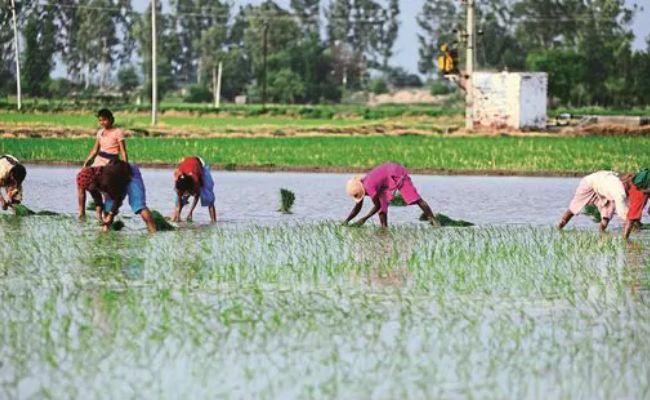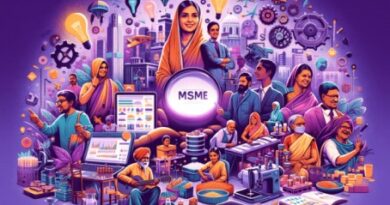The Rural Revival: India’s Quest for a Balanced Development

Introduction
“The soul of India lives in its villages.” Mahatma Gandhi’s famous quotes still hold for modern India. Rural India is home to around 63.40% of the country’s population. The Reserve Bank of India defines rural areas as those with a population of less than 49,000. The current population of India is 1,453,721,920 as of September 2024, based on Worldometer’s elaboration of the latest United Nations data within which 36.60% of the population is residing urban area and remaining approximately 63.40% of the Indian population residing in rural areas, any strategy aimed at economic revival and growth must centrally include rural development. The Indian Union Budget for 2024-25, presented by the finance minister, has reaffirmed the government’s commitment to rural development. This year’s budget underlines the importance of bolstering the rural economy, recognizing it as the bedrock of India’s overall economic framework.
Significance of Rural Economy and Historical Perspective
With agriculture as its cornerstone, the rural economy contributes significantly to India’s economic growth engine. India’s rural economy has always been a cornerstone of its national economic structure. Historically, India’s rural heartland has been agrarian, with agriculture contributing a significant portion to its GDP (Gross Domestic Product). However, the rural economy extends beyond agriculture, encompassing rural industries, artisanal crafts, and Micro, Small and Medium-sized enterprises (MSMEs).
Traditionally, rural India has been characterized by subsistence agriculture, but over the decades, there has been a shift towards diversification with rural non-farm activities. This historical evolution emphasizes the transformative potential embedded within the rural economy. Between 2013-14 and 2023-24, the agriculture sector has grown at an annualised growth rate (CAGR) of 4% at constant prices. Further, in rural regions, between 2017-18 and 2022-23, the Female Labour Force Participation Rate (FLFPR) for women aged 15 years and above rose from 25% to 42%. FLFPR tracks the percentage of women who are either working or looking for work. A higher rate indicates increasing willingness among women to take part in economic activities. As per the Periodic Labour Force Survey (PLFS) 2022-23, the rise in women’s participation has mostly come through self-employment. In 2022-23, 71% of the rural working women were self-employed. Of these, 43% worked as ‘helpers in household enterprise’, for which they did not receive any regular wages.
In 2022-23, 21% of rural working women sought work as labourers and 8% had found work with regular wages. According to PLFS, the unemployment rate for women has gone down in rural areas from 4% in 2017- 18 to 2% in 2022-23. 10 The unemployment rate for men in rural areas has gone down from 6% in 2017-18 to 3% in 2022-23. However, the India Employment Report 2024 by the International Labour Organisation observed that in 2022, the labour force participation rate for young men (61%) was almost three times higher than young women (21.7%) in both rural and urban areas.11 The report also noted a gap in average earnings of men and women in both rural and urban areas. In 2022, the gap in income between male and female workers was highest for self-employed workers in rural areas.
Trends in Growth or Decline:
A critical analysis of data over the last two decades reveals mixed trends in the rural economy:
1. Agricultural Growth and Diversification: Agriculture remains the mainstay of the rural economy, contributing significantly to overall growth. The survey highlights the importance of crop diversification in mitigating risks and enhancing farmers’ incomes. Agricultural GDP growth, which was at an average of 2-3% in the early 2000s, has shown signs of variability due to factors such as monsoon dependency and climate change. According to the Ministry of Agriculture, the sector grew at 4% during the period of 2011-2015 but saw a declining trend in subsequent years, partly due to structural issues and market fluctuations. Government initiatives like the Pradhan Mantri Kisan Samman Nidhi (PM-KISAN) and the National Food Security Act (NFSA) have played a crucial role in supporting rural livelihoods.
2. Progress in Poverty Reduction: As per Economic Survey 2023-24 the significant strides made in reducing poverty in rural India by the Indian Government. The national Multidimensional Poverty Index (MPI) has been halved from 0.117 in 2015-16 to 0.066 in 2019-21. Rural areas have been instrumental in driving this decline, with states like Bihar, Madhya Pradesh, Uttar Pradesh, Odisha, and Rajasthan witnessing substantial improvements.
3. Livestock and Allied Sectors: The livestock sector, including dairy, poultry, and fisheries, is emerging as a key growth driver in rural areas. The survey emphasizes the potential of these sectors in generating employment and improving rural incomes. Government schemes like the National Livestock Mission and the Pradhan Mantri Matsya Sampada Yojana are promoting the development of these sectors.
4. Rural Infrastructure Development: The government’s focus on rural infrastructure development. Initiatives like the Pradhan Mantri Gram Sadak Yojana (PMGSY) and the Jal Jeevan Mission are improving connectivity and access to basic amenities in rural areas. These investments are expected to boost economic activity and enhance the quality of life for rural communities.
5. Rural Entrepreneurship and Micro, Small, and Medium Enterprises (MSMEs): The survey recognizes the potential of rural entrepreneurship and MSMEs in driving economic growth and job creation. Government programs like the Pradhan Mantri Awaas Yojana (PMAY) and the Mudra Yojana are supporting the growth of these enterprises. Encouraging rural entrepreneurship can help diversify rural livelihoods and reduce dependence on agriculture.
6. Digital Inclusion and Financial Empowerment: The survey emphasizes the importance of digital inclusion in empowering rural communities. Initiatives like the Pradhan Mantri Jan Dhan Yojana (PMJDY) and the Digital India program are expanding financial access and digital literacy in rural areas. Digital inclusion can facilitate better access to information, markets, and services, improving the livelihoods of rural people.
Challenges in Rural Development in India
Rural development in India faces several challenges:
1. Economic Challenges
- Poverty and Inequality: A significant portion of the rural population lives below the poverty line, with vast disparities in income and wealth distribution. This limits their ability to invest in education, healthcare, and other essential services.
- Agricultural Dependence: The rural economy is heavily reliant on agriculture, which is often vulnerable to fluctuations in rainfall, crop prices, and market conditions. This dependence makes rural livelihoods precarious.
- Lack of Diversification: The rural economy lacks sufficient diversification, limiting opportunities for income generation and reducing resilience to shocks.
- Infrastructure Deficiencies: Inadequate infrastructure, such as roads, electricity, and irrigation, hampers economic growth and development in rural areas.
2. Social Challenges
- Education and Skill Development: Limited access to quality education and skill development opportunities restricts the potential of rural youth. This contributes to unemployment and underemployment.
- Healthcare: Rural areas often suffer from inadequate healthcare facilities, leading to poor health outcomes and increased vulnerability to diseases.
- Gender Inequality: Women face significant discrimination and limitations in rural areas, affecting their access to education, employment, and property rights.
- Social Exclusion: Certain marginalized groups, such as Scheduled Castes, Scheduled Tribes, and other backward classes, face social exclusion and discrimination, limiting their opportunities for development.
3. Environmental Challenges
- Climate Change: Rural communities are particularly vulnerable to the impacts of climate change, such as droughts, floods, and soil erosion. These environmental challenges can disrupt livelihoods and exacerbate poverty.
- Natural Resource Depletion: Overexploitation of natural resources, such as forests and water, can lead to environmental degradation and unsustainable development.
- Pollution: Pollution from industrial activities and agricultural practices can have adverse effects on the health of rural communities and the environment.
4. Institutional Challenges
- Governance and Corruption: Weak governance, corruption, and lack of accountability can hinder effective implementation of development programs and divert resources.
- Land Reforms: Incomplete or ineffective land reforms can limit access to land for small and marginal farmers, hindering agricultural productivity and rural livelihoods.
- Bureaucracy: Inefficient bureaucracy and red tape can delay the implementation of development projects and discourage investment.
- Lack of Coordination: Lack of coordination among different government departments and agencies can result in duplication of efforts and inefficiencies in service delivery.
Government Initiatives to Mitigate Rural Challenges in India
The Indian government has implemented numerous initiatives to address the various challenges faced by rural India. These initiatives span across economic, social, environmental, and institutional domains.
1. Economic Initiatives
- Mahatma Gandhi National Rural Employment Guarantee Act (MGNREGA): Providing 100 days of wage employment to rural households, aimed at guaranteeing livelihood security.
The National Rural Employment Guarantee Act, 2005 provides for 100 days of guaranteed wage employment in a financial year for adults of rural households. The law has been operationalised across the country through the Mahatma Gandhi National Rural Employment Guarantee Scheme. The scheme covers all districts except those with 100% urban population. Any individual who demands work through the scheme is entitled to a daily unemployment allowance if work is not provided within 15 days. The projects taken up under the scheme include those related to digging canals for irrigation, construction of Anganwadi centres, plantation drives, drinking water supply and sanitation.
For 2024-25, the scheme has been allocated Rs 86,000 crore, same as the revised estimates for 2023-24. As MGNREGS is a demand driven scheme, the expenditure rises and falls in response to demand for work in rural areas. It jumped 55% in 2020-21 as the demand for work went up during COVID-19 pandemic driven by people migrating back to villages. The 15th Finance Commission had also noted that the slowdown in aggregate demand during the pandemic had affected the primary sector and severely hit the rural economy. Under the scheme, the amount of work provided is measured through person days. During 2020-21, the total person days of work generated was 389 crore. That declined in the next two years. In 2022-23, it was 296 crore. But in 2023-24, as of August 2024, demand for work increased to 312 crore person days. In 2023-24, the average days of employment per household also saw an uptick. The percentage of people who obtained 100 days of employment rose from 6% in 2022-23 to 8% in 2023-24.
Table: Person days of employment through MGNREGS
| Year | Amount in Crs |
| 2018-19 | 268.00 |
| 2019-20 | 265.00 |
| 2020-21 | 389.00 |
| 2021-22 | 363.00 |
| 2022-23 | 296.00 |
| 2023-24 | 312.00 |
#Sources: MGNREGS Dashboard, as accessed on July 15, 2024.
- Pradhan Mantri Jan Dhan Yojana (PMJDY): This financial inclusion scheme aims to provide basic banking facilities to the unbanked population, particularly in rural areas. PMJDY is a financial inclusion scheme launched by the Government of India in 2014. Its primary objective is to provide universal access to banking facilities to all Indian citizens, especially those in rural areas and marginalized sections of society. Eligible account holders can avail themselves of an overdraft facility of up to Rs. 5,000/-. All account holders are automatically eligible for accidental insurance coverage of Rs. 1 lakh. Account holders can also opt for life insurance coverage of Rs. 30,000 at a nominal premium.
- Pradhan Mantri Kisan Samman Nidhi (PM-KISAN): PM-KISAN is a flagship government scheme in India aimed at providing financial support to small and marginal farmers. It was launched in 2019 with the objective of supplementing the income of these farmers and ensuring their economic security. The scheme benefits small and marginal farmers with cultivable land of up to 2 hectares. Eligible farmers receive an annual income support of Rs. 6,000, which is transferred directly to their bank accounts in three installments of Rs. 2,000 each. PM-KISAN utilizes DBT to ensure timely and transparent transfer of funds.
- Deen Dayal Antyodaya Yojana – National Rural Livelihood Mission: The Deendayal Antyodaya Yojana-National Rural Livelihood Mission (DAY-NRLM) aims to reduce poverty in rural areas by giving poor households access to finances and employment opportunities. The scheme attempts to mobilise households through self-help groups (SHGs), create community funds, and enhance access to credit and financial services. In 2023-24, one of the targets under the scheme was to provide credit access to 41 lakh SHGs through banking linkage. The programme achieved 81% of its target, providing bank linkage for 33.5 lakh SHGs. In terms of providing financing, the programme had the target of disbursing Rs 1,43,110 crore and achieved 83% of its target with disbursement of Rs 1,19,270 crore.
- Atmanirbhar Bharat Abhiyan: Atmanirbhar Bharat Abhiyan (Self-Reliant India Mission) is a significant initiative launched by the Government of India in 2020 to promote self-reliance and reduce dependence on imports. It aims to make India a global manufacturing hub and enhance its economic self-sufficiency.
- Digital India Land Records Modernisation Programme: Digital India Land Records Modernisation Programme (DILRMP). DILRMP was launched in 2016 to modernise the management of land records. The objective of the scheme is to provide access to comprehensive information about land records, which would lead to, (i) optimum use of land resources, (ii) reduction in the number of land disputes, and (iii) efficient collection of land revenue. DILRMP has been allocated Rs 141 crore in 2024-25, which is 13% higher than the revised estimates for the previous year but 28% lower than the budget estimate for that year. Apart from three years between 2017-18 to 2019-20, fund utilisation under the scheme has remained above 90%. In 2021-22 and 2022-23, the actual expenditure even exceeded the budget estimates. Data on land records is available in the form of text and spatial data. Text data includes records of rights, which provide information about ownership of land, its use and irrigation status. Spatial data involves cadastral maps which contain information about the division of land and boundaries. Under the programme, cadastral maps are being digitised with modern Geographic Information System (GIS) encoding.
2. Social Initiatives
- Sarva Shiksha Abhiyan (SSA): This program aims to provide universal elementary education to all children, including those in rural areas. is a flagship government program in India aimed at providing universal elementary education to all children aged 6-14 years. Launched in 2001, SSA focuses on ensuring that all children, regardless of their gender, caste, or socioeconomic background, have access to quality education.
- Pradhan Mantri Awas Yojana (Gramin): Focuses on housing for all, targeting to build millions of affordable homes for the rural poor PMAY (G) was launched in 2016 to address gaps in the demand and supply of rural housing. It aimed to ensure housing for all by 2022. Based on the Socio Economic and Caste Census (SECC), 2011, the housing shortage in rural areas was estimated to be 4.03 crore. PMAY(G) had the target to build 2.95 crore pucca houses in rural areas in two phases. In Phase I, the target was to build one crore houses between 2016 and 2019. In Phase II, 1.95 crore houses were targeted to be built between 2019 and 2022. By 2022, a total of 2.10 crore houses had been completed under both the phases. The programme was extended till March, 2024 to meet the targets. For 2024-25, the scheme has been allocated Rs 54,500 crore, an increase of 70% over the revised estimate of 2023-24.
- Pradhan Mantri Gram Sadak Yojana (PMGSY): To enhances rural connectivity by building all-weather roads to unconnected villages the government had launched the Pradhan Mantri Gram Sadak Yojana (PMGSY) in 2000 to address poor connectivity in rural areas. The scheme is being implemented across four verticals to provide all weather road connectivity to all eligible rural habitations. In 2024-25, it has been allocated Rs 12,000 crore, 29% less than the revised estimate for 2023-24. PMGSY has four verticals:-
- The first one targets habitats with a population of more than 250 people and it was extended till September 2022.
- The second vertical targets to upgrade 50,000 km of roads which are through routes and act as major links.
- The third vertical, launched in 2019, targets to consolidate 1.2 lakh km of roadways that connects markets and city centres.
- The Road Connectivity Project for Left Wing Extremism Affected Areas (RCPLWEA) was launched as a separate vertical in 2016 and was to be implemented till March, 2023. As of July, 2024, out of the 8,22,351 km of road sanctioned under the scheme, 92% of the roads have been completed.
- Table: Length of road sanctioned and completed under different verticals of PMGSY (in km)
| Vertical | Sanctioned | Completed | Completion Rate |
| PMGSY I | 6,44,885 | 6,24,129 | 97% |
| PMGSY II | 49,857 | 48,874 | 98% |
| PMGSY III | 1,15,446 | 77,879 | 67% |
| RCPLWEA | 12,163 | 8,961 | 74% |
| Total | 8,22,351 | 7,59,844 | 92% |
#Sources: PMGSY Dashboard as accessed on July 15, 2024
- National Health Mission (NHM): NHM is a flagship health initiative launched by the Government of India in 2005. It aims to improve the health status of the people of India, especially women, children, and those in rural areas. The mission is implemented in partnership with states and union territories. NHM aims to reduce maternal mortality ratio (MMR) to 100 per 100,000 live births by 2025. The mission seeks to reduce infant mortality rate (IMR) to 28 per 1,000 live births by 2025.
- National Rural Health Mission (NRHM): NRHM was a flagship health initiative launched by the Government of India in 2005 with the aim of improving healthcare delivery in rural areas. It was merged with the National Health Mission (NHM) in 2013, forming a unified health mission for the country.
- Pradhan Mantri Krishi Sinchai Yojana – Watershed Development Component (PMKSY-WDC): PMKSY-WDC is being implemented to improve the productive potential of rainfed and degraded land. PMKSY-WDC is being implemented in two phases. PMKSY-WDC 1.0 was implemented from 2009-10 to 2014-15. PMKSY-WDC 2.0 was launched in 2021-22 and is expected to continue till 2025-26. WDC has several components meant for improving use of degraded land. These include afforestation, horticulture and construction of water harvesting structures in 2024-25, the scheme accounts for 94% of the Department’s allocation. Expenditure on PMKSY-WDC is estimated to be Rs 2,501 crore in 2024-25, a 43% increase over the revised estimate of 2023-24. Since 2015-16, allocation to the scheme has grown at an annualised rate (CAGR) of 6%. At the same time, fund utilisation under the scheme has remained low, even below 50% for some years. However, in 2023-24, the revised estimate is 80% of budget estimate, suggesting improved fund utilisation
3. Environmental Initiatives
- National Afforestation Programme (NAP): The National Afforestation Programme (NAP) was launched by the Government of India in 1992. NAP is a flagship program launched by the Government of India to increase forest cover and protect biodiversity. The program aims to address the challenges of deforestation, land degradation, and climate change. It is a long-term program with no specific target date for completion. The program aims to increase forest cover in the country gradually over time.
- National Rural Drinking Water Programme (NRDWP): NRDWP is a flagship government initiative in India aimed at providing safe drinking water to all rural households. Launched in 1996, NRDWP seeks to address the critical issue of water scarcity and contamination in rural areas. As of 2023, the NRDWP has achieved significant progress in providing piped water supply to rural households. However, there are still gaps to be filled, especially in remote and marginalized regions.
- National Solar Mission: National Solar Mission is a flagship initiative launched by the Government of India in 2008 with the aim of promoting solar energy development in the country mainly in rural area. The mission aims to harness India’s abundant solar energy potential and reduce dependence on fossil fuels.
4. Institutional Initiatives
- Gram Sabha: This is a village assembly that empowers local communities to participate in decision-making and development planning.
- Panchayati Raj Institutions (PRIs): These local self-governing bodies play a crucial role in rural development, decentralizing power and improving governance.
These are just a few examples of the many initiatives taken by the Indian government to mitigate the challenges faced by rural India. The effectiveness of these initiatives depends on various factors, including adequate funding, effective implementation, and community participation. It is essential to continuously monitor and evaluate these programs to ensure they are achieving their intended objectives and making a positive impact on rural lives.
Learning from Other Countries
Several countries have successfully transformed their rural economies, offering valuable lessons for India:
1. China’s Poverty Alleviation Programs:
- Targeted Approach: China’s poverty alleviation programs have been highly effective due to their targeted approach, focusing on specific regions and vulnerable populations.
- Infrastructure Development: Significant investments in rural infrastructure, such as roads, bridges, and irrigation systems, have played a crucial role in poverty reduction.
- Community-Based Initiatives: China has emphasized community-based initiatives, empowering local communities to participate in development planning and implementation.
2. Brazil’s Bolsa Família Program:
- Conditional Cash Transfers: This social safety net program provides conditional cash transfers to poor families, incentivizing them to keep their children in school and access healthcare.
- Poverty Reduction: Bolsa Família has been instrumental in reducing poverty and improving educational and health outcomes in rural areas.
- Targeted Approach: The program is targeted towards the most vulnerable households, ensuring that resources are allocated effectively.
3. South Africa’s Rural Development Program:
- Land Reform: South Africa’s land reform program aims to redress historical injustices and provide land to previously disadvantaged communities.
- Agricultural Support: The government provides agricultural support, including training, subsidies, and access to markets, to help rural farmers improve their livelihoods.
- Community Development: Community development initiatives are promoted to empower rural communities and enhance their participation in decision-making.
4. Mexico’s Oportunidades Program:
- Conditional Cash Transfers: Similar to Brazil’s Bolsa Família, Oportunidades provides conditional cash transfers to poor families.
- Education and Health: The program emphasizes education and health outcomes, with a focus on early childhood development.
- Poverty Reduction: Oportunidades has been successful in reducing poverty and improving the well-being of rural households.
5. Vietnam’s Community-Based Natural Resource Management (CBNRM) Program:
- Sustainable Resource Management: CBNRM empowers local communities to manage natural resources sustainably.
- Biodiversity Conservation: It has helped to protect biodiversity and improve ecosystem health.
- Community Development: CBNRM has also contributed to community development and poverty reduction.
Conclusion and Way Forward
The various reform initiative of our country reflects a comprehensive strategy to promote rural development, essential for India’s sustainable economic growth. With the right policy mix, bolstered by adequate funding and focused implementation, India can overcome its rural development challenges.
Going forward, there needs to be an emphasis on:
- Holistic Development: Integrating agricultural and non-agricultural sectors for a diversified rural economy.
- Environmental Sustainability: Promoting sustainable land and resource management practices to protect the environment and mitigate the impacts of climate change.
- Public-Private Partnerships: Leveraging private sector expertise and investment for infrastructure and service delivery.
- Community Participation: Involving local communities in planning and implementation to ensure relevance and ownership.
- Good Governance: Strengthening governance institutions and promoting transparency and accountability in rural development programs.
- Inclusive Growth: Promoting inclusive growth that benefits all segments of the rural population, including marginalized communities and women.
- Sustainable Agriculture: Encouraging sustainable agricultural practices that enhance productivity, protect the environment, and improve the livelihoods of farmers.
- Education and Skill Development: Providing quality education and skill development opportunities for rural youth to enhance their employability and entrepreneurial skills.
- India stands at the cusp of potential economic transformation; transforming its rural landscape into a growth engine can lead to inclusive prosperity and enhanced national strength. Improving the lives of millions of people and contributing to the overall progress of the nation. The vision laid out by India is, therefore, not merely desirable but indispensable for India’s future trajectory.




